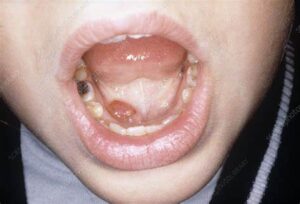What is it?
A ranula is a type of mucocele that occurs in the floor of the mouth. It is characterized by the formation of a cystic swelling or bluish mass due to the accumulation of saliva from a ruptured or obstructed salivary gland duct, typically the sublingual gland. Ranulas are usually painless and benign, but they can cause discomfort or interfere with speaking, eating, or swallowing if they become large or symptomatic.
Here are some key points about ranulas:
- Types: Ranulas are classified into two main types based on their location within the floor of the mouth:
- Simple ranula: This type of ranula arises from the sublingual gland and presents as a cystic swelling beneath the tongue’s mucosa. Simple ranulas may be unilateral or bilateral and typically appear as translucent or bluish in color.
- Plunging or cervical ranula: In this type, the ranula extends beyond the floor of the mouth into the neck, often along the submandibular space. Plunging ranulas may result from the rupture of a simple ranula or from direct extension of the sublingual gland duct into the neck.
- Causes: The exact cause of ranulas is not always clear, but they are thought to result from trauma, inflammation, or obstruction of the salivary gland ducts. Obstruction of the sublingual gland duct, often due to mucous plugs or calculi, leads to the accumulation of saliva within the gland and subsequent formation of a cystic swelling.
- Symptoms: Ranulas are typically painless and may go unnoticed until they become large enough to cause swelling or interfere with oral function. In some cases, ranulas may cause discomfort, difficulty speaking, eating, or swallowing, or a sensation of fullness or pressure in the floor of the mouth.
- Diagnosis: Diagnosis of ranulas is typically based on clinical examination and imaging studies, such as ultrasound, CT scan, or MRI, which can help visualize the size, location, and extent of the lesion. Fine needle aspiration or biopsy may be performed to confirm the diagnosis and rule out other potential causes of a neck mass.
- Treatment: Treatment of ranulas depends on the size, location, and symptoms of the lesion. Small, asymptomatic ranulas may be managed conservatively with observation and periodic follow-up. Symptomatic or enlarging ranulas may require intervention, such as aspiration (drainage) of the cystic fluid, marsupialization (creation of a surgical opening) to promote drainage and prevent recurrence, or surgical excision of the ranula and associated salivary gland tissue. Recurrent or refractory ranulas may necessitate more extensive surgical procedures or referral to a specialist.
In summary, a ranula is a cystic swelling in the floor of the mouth caused by the accumulation of saliva from a ruptured or obstructed salivary gland duct. While usually painless and benign, ranulas can cause discomfort or interfere with oral function if they become symptomatic or enlarging. Treatment options vary depending on the size, location, and symptoms of the ranula but may include observation, drainage, or surgical excision. Early diagnosis and appropriate management are important for preventing complications and achieving favorable outcomes.

